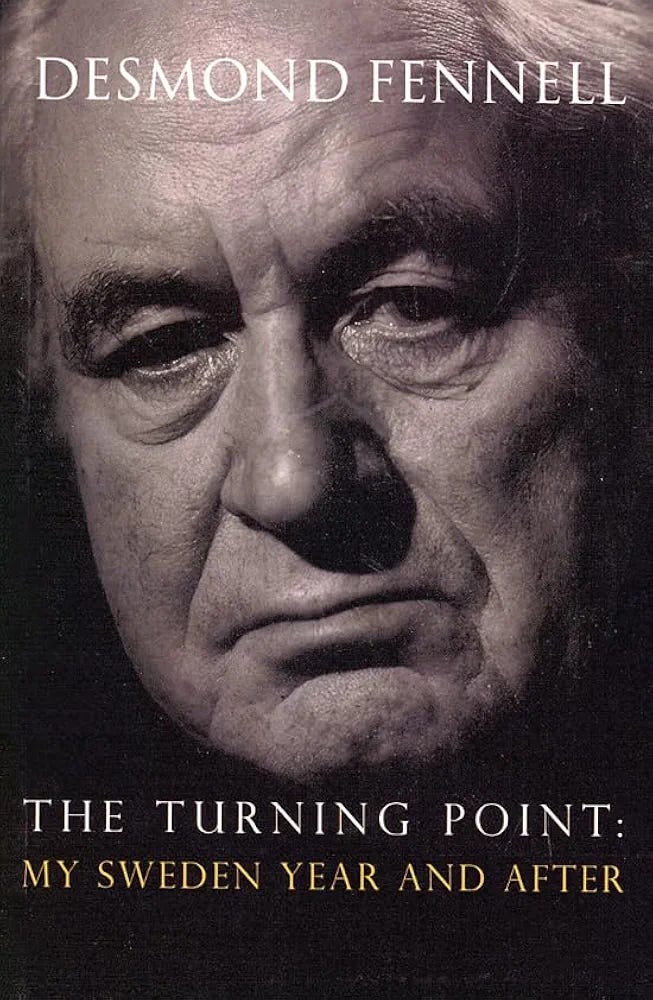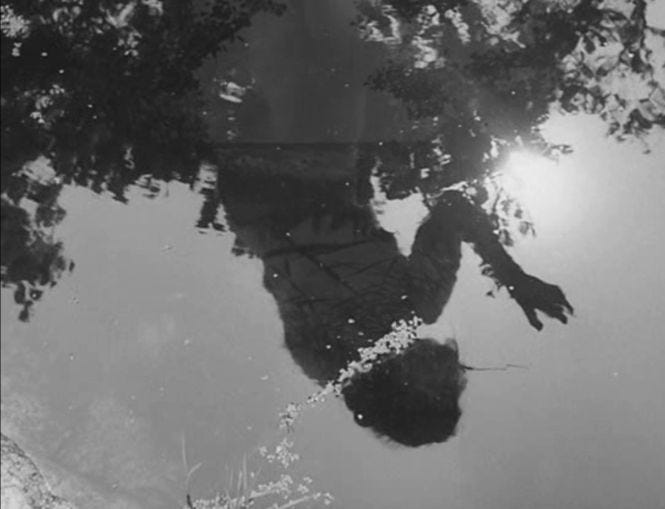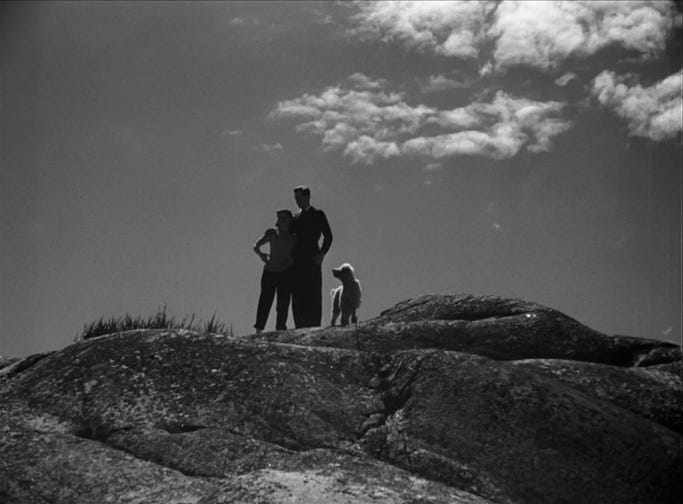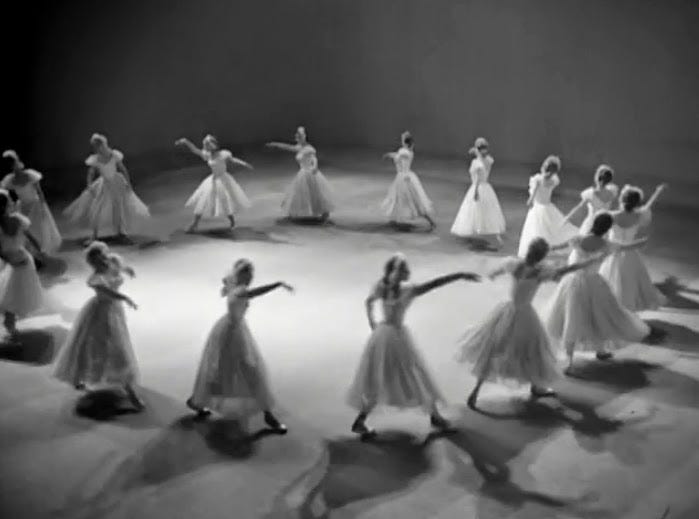'Goodbye to Summer': Ingmar Bergman's post-war Sweden as a symbol of technocratic cultural malaise (Fennellism, p. 3)
As a young writer Desmond Fennell questioned how such a wealthy state as post-war Sweden could be consumed by life-denying ennui (as in Bergman's films). His answer shocked US President Eisenhower.
Fennell’s travels in Sweden’s supposed liberal utopia1
‘Only in the last few weeks, I have been reading quite an article on the experiment of almost complete paternalism in a friendly European country. This country has a tremendous record for socialistic operation, following a socialistic philosophy, and the record shows that their rate of suicide has gone up almost unbelievably and I think they were almost the lowest nation in the world for that. Now, they have more than twice our rate. Drunkenness has gone up. Lack of ambition is discernible on all sides.’—US President Eisenhower at the Republican National Comvention.
‘This article, while eliciting a furious response from the Swedish media and to a lesser degree in The Spectator, was reprinted in the Washington Post and referred to admonishingly by President Eisenhower.’—Fennell, About Being Normal, p. 37.
Over the late 1950s and early 1960s, a young Desmond Fennell was began his career as a travel writer. Typical of his scope and vision, even at such an early stage as an aspirant, he embarked on a quest to diagnose the crisis of decadence and collapse within the culture of the West. In particular, he caused a firestorm for his intellectual assault on Sweden, after having lived there for a few months.
He explained his reasoning for focusing on Sweden as that it was commonly marketed as the ‘post-Christian’ future of the West:
‘then regarded as the avant-garde country of the West on account of its innovative social welfare system and its “pagan” sexual mores.’2
The high hopes of that period for Sweden's near-utopian project was described by Fennell as like an ‘attractive’ post-scarcity society, where the seemingly eternal questions of poverty and meaning would be solved. This was supposed to lead to a society of fuller, happier, more liberated men and women as workers, as well a more life-embracing, forward-looking society:
‘In short, were the great dreams and hopes that had animated European society and drove it forward during 1,500 years of poverty brought any nearer to their fulfilment now that riches had come?’ — Goodbye to Summer.3
Just as in Bergman’s films, sexual anxieties and a hyper-medicalised approach to love dominated Swedish life. In one infamous line, Fennell noted how in ‘Ireland people worried about their soul's salvation’ whereas ‘in Sweden people worry about their sex lives’:
‘Many small shops sell nothing but contraceptives and handbooks on sex problems and practice. White coated women stand ready to offer you advice. Slot-machines on the streets provide contraceptives; it's easier to find a contraceptive than a postage stamp.’4
Comments such as these, and others in the article, contributed significantly to the moral panic over ‘Swedish Sin’ which dominated European cultural discourse at the time. Despite this, Fennell's critique never took aim at the country from a Puritan perspective, as he felt its all-encompassing modernism didn’t arise from excessive liberty—but in soft totalitarian control. The endless barrage of products and art which advertised a pervasive sexual and atheistic libertinism was in fact a thin veneer. Its purpose?—to desperately obscure the overwhelmingly colourless and conformist nature of bureaucratic modern life.
Beyond the pomp, there was a deep cultural anxiety over the lack of diversity and danger in everyday life. For all their supposed freedoms, Swedish life was now still under a ‘tightening string which controls life’. Intellectual debate was tightly confined to a centrist dialectic of Christian-Democrats and Social Liberals (with both Marxists and Catholics totally extruded). Indulgences like alcohol were tightly controlled and shamed. Visitors at restaurants would be forced to choose the “correct" meal by waitors. Many people ate and drank alone, with social clubs, sexual life and spontaneity gradually beginning to dissappear from once-crowded city streets.
For Fennell, this created a ‘hateful’ way of life, which suppressed human individuality and creativity:
‘Swedes repeat frequently that they possess freedom of speech, but they talk less than ever before and there is no satire of the sanctimonious Establishment of liberal rationalists, puritanical libertines and respectable money-makers. They assert continuously that there is freedom of thought, but no new thoughts have emerged in years and both philosophy and radical debate have died.
Babies are scarce and the industries have to send as far as Greece to get workers, yet public policy promotes the limitations of families. Women are said to be emancipated. But a woman is regarded as a full women only when she has lain with a man and when she practices (or has learnt to practise) a trade or profession that commands a money wage.’5
One can imagine how this drabness would be so heavily accentuated during the winter, where in some regions the sun does not rise for weeks. In such an environment, one can see why some fell into praying for and even worshipping the Sun as a sort of Olympian savior.
According to Fennell, the early Bergman films Summer Interlude (1951) and Summer with Monika (1953) reflected the ‘myth’ of summer worship that dominated decadent Swedish culture at that time. Based on what Stockholm psychiatrist named Dr Martens had told him, Fennell reported that the coming of summer is so heavily anticipated every year because so many Swedes believed it would somehow cure them of their cultural anxieties and ennui:
‘“Many people live only for summer, they plan all the year what they will do then,” he said. Summer is to bring them perfect happiness—which often includes blissful love; when summer comes and goes and happiness has eluded them, they feel bitter and cheated.’6
In terms of the films of Bergman mentioned, they both play into this cultural form-world, of an imaginary representation of the psychological powers of summer vitalism. Core to this is the basic element of ‘young love in summer landscape ending in autumn tragedy’ and that tragedy in both cases is that of a violent death. There’s a certain latent beauty here, though drenched in melancholy. Who has not, from time to time, fallen into a metaphysical nostalgia for an imagined past, whether as an individual memory or part of a collective unconscious:
‘In Summer Interlude and Summer with Monika the summer landscape is in the Stockholm Archipelago, where tens of thousands of Stockholmers, especially the young and dreaming, seek every summer the Isles of the Blest. In the films Summer with Monika and One Summer of Happiness the moment of complete surrender to love and to nature is identical and is given a quasi-ritual force by the complete nakedness of the boy and the girl and the bathe which precedes their love-union.’7
Bergman’s Monika as heroine of the new post-Christian woman
In terms of characterising the infamous promiscuous nihilism of Swedish post-war society, 1953's Summer with Monika (Sommaren med Monika) can hardly be beaten. Notorious for its boundary pushing nudity, the story follows Monika (played by the famous Harriet Andersson), a working class girl who deapises her job as a vegetable grocer in urban Stockholm. In an act of rebellion from her monotonous worklife, she escapes away to the luscious archipelagos of the city with her lover, Harry (Lars Ekborg), only to result in a disasterous pregnancy. Following this, she has to return to her mumdane life, among those who ‘slave away’ and ‘hold us back and make us crawl’.
As a cinematic ideal, she embodies the crude, orgiastic pagan Summer-worship which Fennell astutely identified:
‘Monika is a force of nature, an affront to civilised society's values, who despises them right back. Out on the archipelago she's in her element and Bergman regularly shoots her as if she were one of the area's native wildlife: stalking through the reeds, scampering along the rocks, scrubbing herself with sea water, whooping, war dancing, even peeing behind a tree. She's all instinct, primal, hungry for life, sex, freedom.’—Singer, Leigh. Look Closer, p.28.
At the time of its release, the film contributed to a dialectic of bureaucratic sterility on the one hand with rampant degeneracy on the other, what Fennell referred to as the ‘angel-whore dichotomy’. Scenes of nude bathing, pre-marital sexuality and youth rebellion solidified the global image of Sweden as a sort of 1960s counter-cultural Weimar—before the decade had even begun:
‘All this struck a chord in those growing up in the late 1950s and early 1960s, taught as they were in the Eisenhower years, in the Erlander years, in the De Gaulle years, to wear the grey flannel suit of convention and to place order above inventiveness. A work like Summer with Monika carried a powerful charge of sexual liberation. Monika lives for each passing day and does not count the cost.’—Hedling, Erik. 2021. Ingmar Bergman: An enduring legacy, p. 24.
Despite mixed reviews, often criticising Monika's behaviour, its explicit content led to it being ‘hacked up and released as exploitation-fare’ in the USA under titles like “Monika – The Story of a Bad Girl”, with a US judge ruling it ‘appealed’ to ‘potential sex murderers’.8
Here one sees the deception or irony implicit in the politics of Monika's sexual revolution. What was intimate and so authentically natural, representative of élan vital—scenes of doomed summer love, frolicking along luscious archipelagos—became instrumentalised by an American empire of consumerist capture. Upon looking at the fatcats and hucksters profiting off of the exploitation of young women like Monika, could one really still refer to this as a straight-forward case of empowering the dignity of women?
As one wonders this, the question of Bergman’s intentions arise too. While Monika was taken to be an icon of the new ‘liberated’ European woman, there is the obvious issue that the film itself ends in great tragedy, for none more than the great rebellious heroine. In her unplanned pregnancy, her infidelity to Harry (her child’s father) and eventually her return to massified wagie life—the supposed victoriousness of these new values are difficult to identify.
A classic image symbolising the seemingly revolutionary aspects of Monika is in the final scene. After lighting a cigarette from her new lover, Bergman has Monika break the fourth wall and face the audience directly—‘shameless, direct contact with the viewer’—while the background fades to black in a part-ominous part-triumphant display, marking the future rebellion of European youth.9
Looking at the details of her face here, there is a subtle desperation within Monika, which even startled the actress who played her:
‘Andersson reminisced on the first time she saw the film, alone, in a small Stockholm cinema. “When I looked into her — my — eyes…” she marvelled, “what I was thinking is, why does she look so sad?”. The tinge of sorrow Andersson identifies comes despite, or perhaps because of, how unapologetic Monika is. Though her imminent actions may lead to a temporary escape, even perhaps a fleeting moment of ecstasy, how can our now shared complicity in her betrayal of Harry be anything other than a tragedy?’ Singer, Leigh. Look Closer, p. 24.
Marie and rationalism's denial of memories
To truly understand Bergman's intentions with Monika, as well as his tragic view of liberal rationalism, it may be worth ending on the second summer classic Fennell eluded to.
Released in 1951, Summer Interlude (Sommarlek) tells the similarly poignant and rebellious story of Marie (Maj-Britt Nilsson), a 28-year-old ballet dancer, who receives the diary of her first love, Henrik (Birger Malmsten), years after his tragic death. Despite being produced before 1953's Monika, the film feels somewhat like a retrospective, nostalgic look on the naive simplicity of that story. As Henrik’s diary prompts Marie to revisit the island where they spent a summer idyll as teenagers, triggering extensive flashbacks to their youthful, ‘shy love’ and idyllic romance, ending abruptly when Henrik dies in a diving accident.
With cinematography bouncing from the cold, muted greys of her modern winter life to the shimmering sunshine of a repressed summer, Fennell’s critique of the Swedish binary is nowhere more astute. Even with all the time that had passed, Marie is utterly grief-stricken by the loss of her youth, and she sees no other future than to throw herself into her monotonous worklife, feeling tormented by memory and becomes a ‘painted puppet’ hiding her trauma. Her return to the island is a therapeutic journey through memory and dreams, confronting reminders of death and past exploitation, aiming to process the past and potentially find a way forward.
Not only Fennell, but also Swedish literary scholar Leif Zern has argued Bergman smuggled through a satire of societal repression in modern Swedish rationalist life. Unlike his later effort which followed the simple linear story of tragedy, Interlude allows the audience to identify directly the long-term effects of this binary dichotomy between sterilised social conformism and ‘liberated’ individual freedoms:
‘Two decades later, critic Leif Zern tried to pin down Bergman’s political views in his book Se Bergman (‘See Bergman’, 1993); but this time, it was an attempt to paint the director as a critic of the social-democratic project. ‘In Bergman’s films, the mirror of the Swedish Welfare State is smashed’, Zern declares, whereupon he asserts that the films show ‘what we had repressed, what we thought of as outdated and, at worst, [as] unfit to live.’—Hedling, Ingmar Bergman, p. 212.
In Zern's view, this is refelcted in Marie's attempt at functioning in modern utopian society by compartmentalising her past passions. The depiction of her life as irrevocably shaped by intense repression and loss, between her internal and external consciousness, highlights how utopian rationalism cannot handle true human diversity. In a perfectly sterilised, politically correct and ‘hygienic’ view of the atomistic individual, the aspects of ourselves which are most human, complicated and broken are deemed ‘unfit to live’ or repressed within a rationalised societal model.
Thankfully for us, Bergman added to this critique with a suggestion of the alternative: a humanist embrace of our past—no matter how complicated, unscientific and messy our roots may be.
This can be seen in Marie's gradual journey of contemplation and remembrance of things past. It begins as she impulsively jumps on a ferry to the Smådalarö archipelago where her and Henrik once frolicked and picked berries together, as in an Arcadian bliss. But this time, in her more mature state, the luscious ‘Wild Strawberries’ take on a psychological form, acting as an involuntary portal into her repressed memories. This allows for a reassessment of her imagined idyllic form-world of past-sunmers. Seen through this Proustian lens, Marie is able to come to mature past her trauma, and recognise the story of her life, which has constrained her from moving forward is, just that—a story:
‘Marie has gained a sense of perspective and a level of maturity that allows her to see this as a way to come to terms with a moment whose reverberations are still felt, however insidiously, in her attempts to enter into an emotional state that will enhance the intensity of her ballet performances.’10
Proust himself dove into the concept of involuntary memory as a portal to a lost noetic form world, particularly by utilising (and perfecting) the stream-of-consciousness prose style. Relevant to the themes of this essay, he also recognised the psychological power of this involuntary memory in transporting us into the matrix of the past and previous generations, reminding us of nations and eras we never experienced. Particularly when his narrator in À la recherche du temps perdu thinks of his Grandmother, as a depositer of not only ancestral memory but also a person who obtains the mental consciousness of a forgotten generational order.
After her death, the protagonist's heart anguishes at past mistakes or sufferings he experienced with his Grandmother, much like Bergman's Marie contorting herself due to her imperfect, human and irrational youth. For Proust, liberation from this ennui lies not in rationalising or boxing off our roots and past trauma, but in recognising the authentic reality of human suffering, embedded into the fabric of who we are and where all our ancestors came from:
‘the dead exist only in us, it is ourselves that we strike without ceasing when we persist in recalling the blows that we have dealt them. To these griefs, cruel as they were, I clung with all my might and main, for I realised that they were the effect of my memory of my grandmother, the proof that this memory which I had of her was really present within me. I felt that I did not really recall her save by grief and should have liked to feel driven yet deeper into me these nails which fastened the memory of her to my consciousness. I did not seek to mitigate my suffering, to set it off, to pretend that my grandmother was only somewhere else and momentarily invisible, by addressing to her photograph (the one taken by Saint-Loup, which I had beside me) words and prayers as to a person who is separated from us but, retaining his personality, knows us and remains bound to us by an indissoluble harmony. Never did I do this, for I was determined not merely to suffer, but to respect the original form of my suffering’
By recognising his suffering, and living with his memories, the narrator is able to live again, integrating himself again into a natural chain of rooted and tangled human sufferings. In a similar sense, Bergman has Marie delve back into her past misfortunes not to dwell on their tragedy, but as an attempt at healing. The journey Marie embarks on is that of a return to humanity, to the cyclical ecology of the soul as a striving, suffering and loving being. Perhaps this humanism is best expressed through art, and dance, as the antithesis of technocratic control and repression.
Humanism and art as the antitode to rootlessness
Marie’s attitude to her ballet performances encapsulates this, as striking at the ontological tension between Swedes’ representations of themselves and their real Dasein (being-in-the-world). Do they allow their theatre to subordinate and instrumentalise genuine trauma into a performance?—or can they develop alongside great Art, allowing for a symbiotic process between Man as imagined and Man as he really is. The simplest way of putting this tension is by reference to GK Chesterton:
‘It is often said we can learn to love the characters in romances as if they were characters in real life. I wish we could love the characters in real life as we love the characters in romances. There are a great many human souls whom we should accept more kindly, and even aopreciate more clearly, if we simply thought of them as people in a story.’11
Despite the anguished state of much of Bergman's portrayal, I still believe there is a relevant Chestertonian message in Marie's suffering. The ending of Summer Interlude suggests we can escape this blinkered, fleeting relationship with our memories as divided between an imagined Arcadian past of summers and today's eternal winter. After all her ballet performances and rehearsals, Marie looks back into the mirror one last time, in a simple gesture of humility, to simply laugh at built-up enniu. In this sense, cultural nihilism is a choice, despair is a choice. Simple humility, rejection of our own imaginary failed importance, can free us to live realized, integrated human lives.
This third part of my Fennellism series was slightly delayed (by a year) due to a separate Irish writer who “““claimed””” to be writing his own piece on this topic :)
About Being Normal, p. 17.
Ibid, p. 39.
Ibid, p. 40.
Ibid.
Ibid, p. 41.
Ibid.
Macnab, Geoffrey. 2009. Ingmar Bergman, p. 81
Ibid.
Jenkins, David. Trauma’s Rainbow, p. 2.
Chesterton, What I Saw In America, p. 257.






